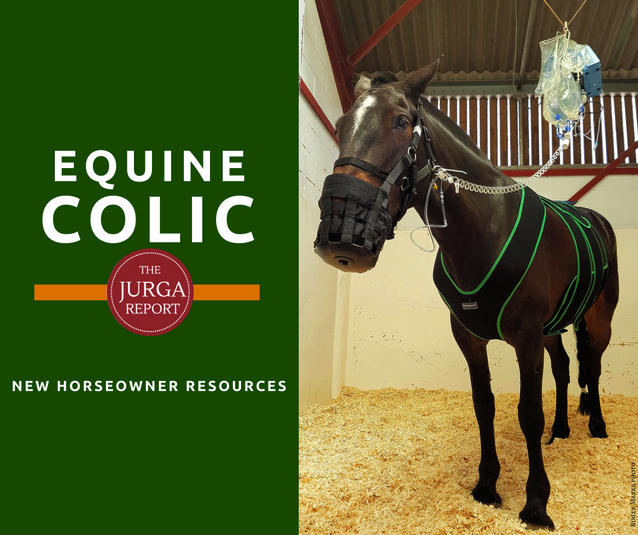
The British Horse Society (BHS) and The University of Nottingham’s School of Veterinary Medicine and Science in England have teamed up to help horse owners combat the life-threatening condition of equine colic. The University of Nottingham has developed ten educational brochures on aspects of colic that can be downloaded from the BHS website. A video on colic recognition for horseowners is now available from the BHS on YouTube, as well.
Earlier today, the “REACT Now to Beat Colic” campaign, including a new information video, was officially launched at the 2016 BHS Stressed out? The Causes, Effects and Prevention of Stress in the Horse and Rider, welfare conference at Hartpury College.
On both sides of the Atlantic, the word “colic” is used as a general term to describe clinical signs of abdominal pain or discomfort in the horse. Technically, “colic” is a symptom rather than a disease in itself.
Colic is the most common equine emergency and cause of death in horses worldwide. It can be a chronic, low-grade problem in some horses, and a one-time severe problem for others, often requiring expensive surgery and an uncertain future for the horses it affects.
Watch the video here:
But as common as colic is, British research found that horse owners have a considerable degree of confusion about it. Colic is more than the lack of manure in a horse’s stall, or noticing that a horse is biting at its belly or rolling more often. Since the symptoms may be missed in a quick check of a horse in the morning when an owner cleans a stall and turns the horse out, the vet school felt that more help was needed. In addition, many of the tried-and-true warning signs can be vague, and some horses may not show
The initiative developed an acronym for colic recognition, termed “REACT”.
R – Restless or agitated
E – Eating less or dropping reduced
A – Abdominal pain
C – Clinical changes
T – Tired or lethargic
The University of Nottingham has spent the past five years trying to reduce the danger of colic for horses by conducting systematic reviews of the evidence on risk factors for colic as well as different diagnostic tests.
he evidence based research, revealed today, also found that colic accounts for one in three emergency veterinary visits. At least one in ten of these cases may be critical, and up to 80% of these critical cases result in death or the horse being euthanized.

The REACT program is designed to help horseowners remember the signs of colic.
“We have also generated new evidence on what happens when vets first see horses with colic and have run surveys, workshops and consensus voting to ask vets and horse owners about their experiences and opinions of colic,” commented Professor Sarah Freeman. “We have identified where more research is needed and generated important new information to inform this campaign.”
Emmeline Hannelly, BHS Welfare Education Officer, was optimistic that these new educational materials will make a difference. “The guides will support horse owners in dealing with colic from its prevention to the worst case scenario of emergency decision making.”
The new research at the University of Nottingham Vet School has found that:
- In a survey of 1,016 horses with colic seen by veterinary practitioners, 19% of cases (195/1016) were critical, and 84% of these (164/195) were euthanized or died.
- In a retrospective study of over 2,500 emergency visits by veterinary practitioners, colic was the most common problem, accounting for nearly a third of all ‘out of hours’ veterinary call outs.
- In a survey of 1,061 horse owners, only 20% could give a correct definition of ‘colic’.
- Horse owners wanted to be involved in assessing their horse’s health, but many did not know the normal heart rate, breathing rate or temperature in the horse (20-30% said they did not know, 30-60% gave values which were wrong).
- Most owners were confident recognizing a severe case of colic (49% of owners were sure it had colic), but less confident recognizing a milder case (only 9% were sure it had colic).
The British Horse Society and The University of Nottingham acknowledged that the leaflets have been written and reviewed by:
- Professor Sarah Freeman, Dr John Burford, Dr Adelle Bowden and Professor Gary England – School of Veterinary Medicine and Science, The University of Nottingham
- Professor Tim Mair – Bell Equine Clinic
- Professor Debbie Archer – University of Liverpool
- The British Horse Society Welfare & Education Teams
Further information and downloadable materials can be downloaded from the BHS website: www.bhs.org.uk/colic
Read more about colic on The Jurga Report:
Groundbreaking Equine Colic Research Project: First Study Results Published
Digesting It All: Equine Colic Research Symposium Papers Available via Open Access
Video: Is Sand Colic the Price Horses Pay for a Snowless Winter?

Click to follow Fran Jurga on Twitter
Click to view (and like) Fran Jurga’s Facebook page








